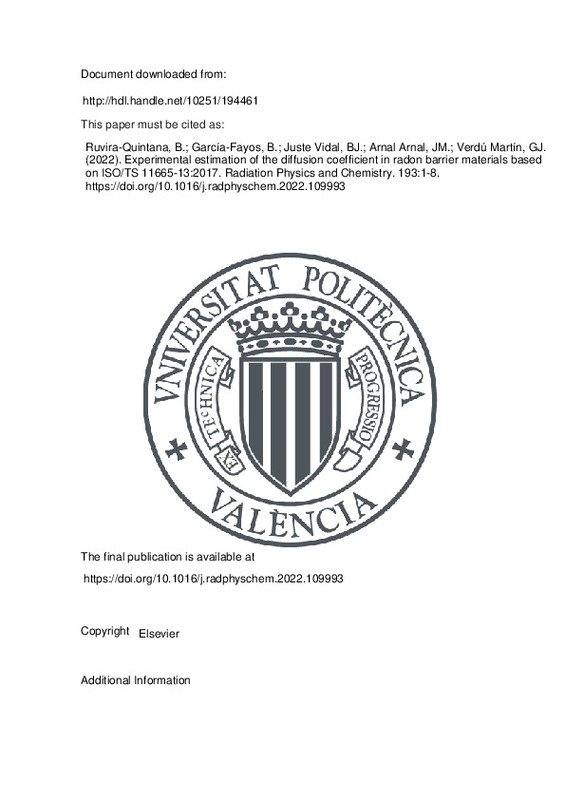JavaScript is disabled for your browser. Some features of this site may not work without it.
Buscar en RiuNet
Listar
Mi cuenta
Estadísticas
Ayuda RiuNet
Admin. UPV
Experimental estimation of the diffusion coefficient in radon barrier materials based on ISO/TS 11665-13:2017
Mostrar el registro sencillo del ítem
Ficheros en el ítem
| dc.contributor.author | Ruvira-Quintana, Beatriz
|
es_ES |
| dc.contributor.author | García-Fayos, Beatriz
|
es_ES |
| dc.contributor.author | Juste Vidal, Belen Jeanine
|
es_ES |
| dc.contributor.author | Arnal Arnal, José Miguel
|
es_ES |
| dc.contributor.author | Verdú Martín, Gumersindo Jesús
|
es_ES |
| dc.date.accessioned | 2023-06-21T18:01:53Z | |
| dc.date.available | 2023-06-21T18:01:53Z | |
| dc.date.issued | 2022-04 | es_ES |
| dc.identifier.issn | 0969-806X | es_ES |
| dc.identifier.uri | http://hdl.handle.net/10251/194461 | |
| dc.description.abstract | [EN] Due to the health risks posed by high radon concentrations, many regulations impose concentration restrictions and set out several techniques to prevent radon entry into enclosed spaces. One of the most effective technique to protect new buildings from radon entry is to install a radon barrier over the entire surface of the ground beneath the foundation. Whether a barrier is suitable for protection is determined by the diffusion coefficient, the methodology which is standardised in ISO/TS 11665-13:2017. These barriers are typically made of polymeric or bitumen materials, which have diffusion coefficients between 10(-11) and 10(-13) m(2)/s. By applying a modification to the ISO standard that allows shorter test times, the diffusion coefficients of a commercial membrane (6.21 +/- 0.75 .10(-13)), polyethene (1.14 +/- 0.14 .10(-12)), polypropylene (4.35 +/- 0.53 .10(- 14)), polyvinyl chloride (3.55 +/- 0.43 .10(-14)), polystyrene (4.96 +/- 0.60 .10(-13)) and polymethyl methacrylate (4.07 +/- 0.49 .10(-13)) have been measured, the latter two material values not being published so far. The results validate the developed methodology since the diffusion coefficients provided are comparable with those of the literature. In all cases, a concentration reduction of 99% is obtained. A relationship is observed between the amount of radon adsorbed by the material and its thickness and chemical composition. | es_ES |
| dc.description.sponsorship | This work is financed by the Operational Programme 2014-2020 Comunitat Valenciana of the European Regional Development Fund and the Generalitat Valenciana under the projects Bioingenieria de las Radiaciones Ionizantes. Biorad (PROMETEO/2018/035) and MEMO RADION (IDIFEDER/2018/038) and also by the European Social Fund through Ayuda Garantia Juvenil Gva-Capacidades de deteccion del Laboratorio de Radiaciones Ionizantes (GJIDI/2018/A/016). The authors would like to thank Radiansa for providing some of the material used in the tests and Gdes for their collaboration during the research. | es_ES |
| dc.language | Inglés | es_ES |
| dc.publisher | Elsevier | es_ES |
| dc.relation.ispartof | Radiation Physics and Chemistry | es_ES |
| dc.rights | Reconocimiento - No comercial - Sin obra derivada (by-nc-nd) | es_ES |
| dc.subject | Radon | es_ES |
| dc.subject | Diffusion coefficient | es_ES |
| dc.subject | Radon barrier | es_ES |
| dc.subject | Polymeric material | es_ES |
| dc.subject.classification | INGENIERIA QUIMICA | es_ES |
| dc.subject.classification | INGENIERIA NUCLEAR | es_ES |
| dc.title | Experimental estimation of the diffusion coefficient in radon barrier materials based on ISO/TS 11665-13:2017 | es_ES |
| dc.type | Artículo | es_ES |
| dc.identifier.doi | 10.1016/j.radphyschem.2022.109993 | es_ES |
| dc.relation.projectID | info:eu-repo/grantAgreement/EDUC.INVEST.CULT.DEP//IDIFEDER%2F2018%2F038//LABORATORIO MOVIL DE ANALISIS DE RADIACIONES IONIZANTES (LABRADIO)/ | es_ES |
| dc.relation.projectID | info:eu-repo/grantAgreement/EDUC.INVEST.CULT.DEP//GJIDI%2F2018%2FA%2F016//AYUDA GARANTIA JUVENIL GVA-CAPACIDADES DE ANALISIS Y DETECCION DEL LABORATORIO DE RADIACIONES IONIZANTES/ | es_ES |
| dc.relation.projectID | info:eu-repo/grantAgreement/GENERALITAT VALENCIANA//PROMETEO%2F2018%2F035//BIOINGENIERIA DE LAS RADIACIONES IONIZANTES. BIORA/ | es_ES |
| dc.rights.accessRights | Abierto | es_ES |
| dc.contributor.affiliation | Universitat Politècnica de València. Escuela Técnica Superior de Ingenieros Industriales - Escola Tècnica Superior d'Enginyers Industrials | es_ES |
| dc.description.bibliographicCitation | Ruvira-Quintana, B.; García-Fayos, B.; Juste Vidal, BJ.; Arnal Arnal, JM.; Verdú Martín, GJ. (2022). Experimental estimation of the diffusion coefficient in radon barrier materials based on ISO/TS 11665-13:2017. Radiation Physics and Chemistry. 193:1-8. https://doi.org/10.1016/j.radphyschem.2022.109993 | es_ES |
| dc.description.accrualMethod | S | es_ES |
| dc.relation.publisherversion | https://doi.org/10.1016/j.radphyschem.2022.109993 | es_ES |
| dc.description.upvformatpinicio | 1 | es_ES |
| dc.description.upvformatpfin | 8 | es_ES |
| dc.type.version | info:eu-repo/semantics/publishedVersion | es_ES |
| dc.description.volume | 193 | es_ES |
| dc.relation.pasarela | S\462583 | es_ES |
| dc.contributor.funder | GENERALITAT VALENCIANA | es_ES |
| dc.contributor.funder | European Regional Development Fund | es_ES |







![[Cerrado]](/themes/UPV/images/candado.png)

